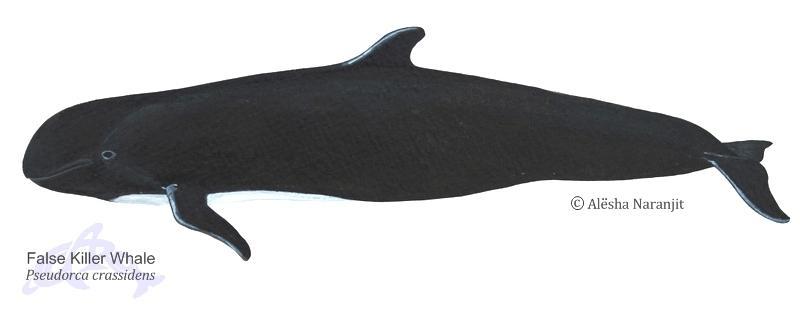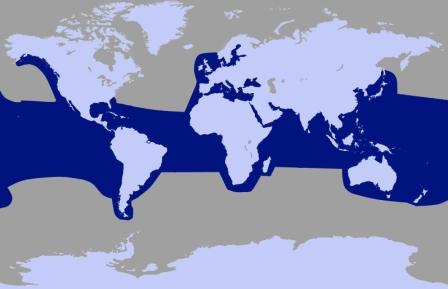Pseudorca crassidens

Classification Other Names: False Pilot Whale, Pseudorca Suborder: Odontoceti Family: Delphinidae | Description
False Killer Whales have long, slender, uniformly black or dark-grey bodies and blunt conical heads with a pronounced melon.The flippers are characteristically elbow-shaped and the dorsal fin set mid-way along the back, is large and falcate with a flat top. Some individuals have a grey head and sides and a pale W on the chest. This is the only blackfish that bow-rides frequently. It is typically fast moving and often acrobatic but can move at the surface showing little more than a dorsal fin. These animals have been known to steal fish off longlines and often associate with other cetaceans especially bottlenose dolphins.
|
False Killer Whale Ecology Range:Tropical and warm temperate waters usually between 50°N and 52°S. Usual Habitat: Relatively deep, offshore waters but sometimes found in shallow, coastal waters. Usual group size: Strongly bonded groups of 10 - 50 individuals, sometimes up to 300 animals. Main Diet: Primarily cephalopods and fish (including large species such as tuna and mahi-mahi) and sometimes they attack small cetaceans, Humpback Whales and Sperm Whales. Local population: Unknown | Global range of the False Killer Whale  Dark blue areas indicate where False Killer Whales are likely to be found |
Protection and Conservation Status
IUCN Conservation Status: False Killer Whales are listed as "Data Deficient" on the IUCN red list. SPAW Protocol: False Killer Whales are cetaceans, which are listed under Annex II of the SPAW protocol. As such they require total protection under article 11 of this protocol which prohibits the "taking, possession, killing and commercial trade of the species, their parts or products". The SPAW protocol was created to help with the implementation and promotion of the Ramsar Convention and the Convention on Biological Diversity. The Annexes of the SPAW protocol can be found here. Local Laws: Cetaceans are protected under the Conservation of Wildlife Act of Trinidad and Tobago which offers protection to all species not listed under the second or third schedules of this act. |
This is currently being researched and written. It will appear here shortly.
References
The above information was obtained from the following sources:
- A Princeton Field Guide: Whales Dolphins and Other Marine Mammals of the World by Hadoram Shirihai and Brett Jarrett (2006)
- Smithsonian Handbooks: Whales Dolphins and Porpoises by Mark Carwardine and illustrated by Martin Camm (2002)
- The Whale and Dolphin Conservation Society's Species Guide at http://www2.wdcs.org/species/index.php
- The IUCN Redlist at http://www.iucnredlist.org
- The SPAW protocol Annexes with links available at http://www.car-spaw-rac.org/?Annexes-of-the-SPAW-Protocol,83
Acknowledgements
We would like to thank the following people for the use of the art work and photographs:
- Alësha Naranjit (Illustration of False Killer Whale)